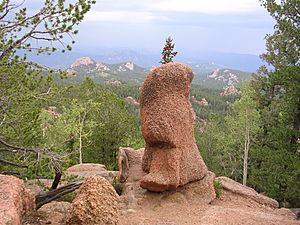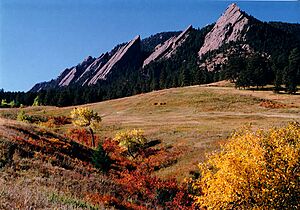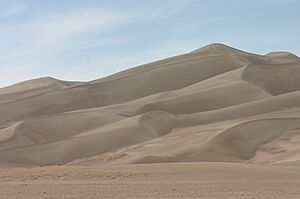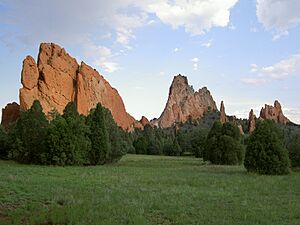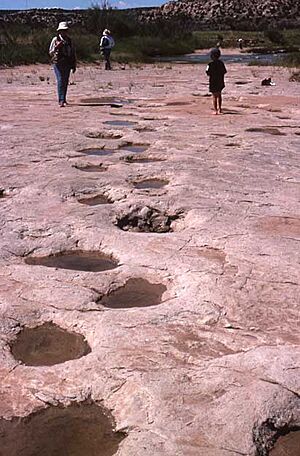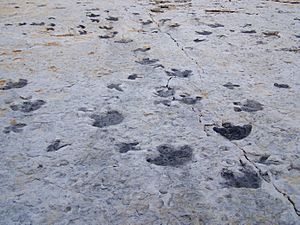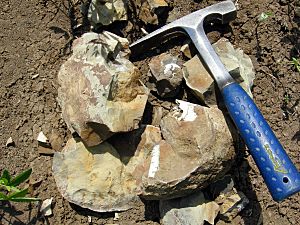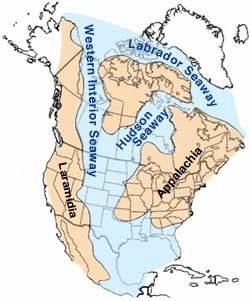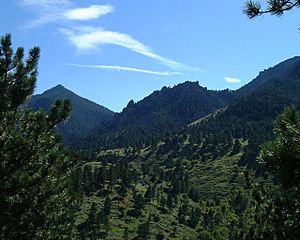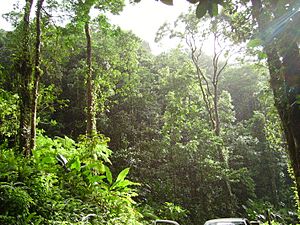Prehistory of Colorado facts for kids
Prehistory of Colorado tells the story of what happened in Colorado long before people started writing things down. Over billions of years, Colorado's land was shaped by huge natural events. These included giant ice ages, warm tropical oceans, and massive volcanic eruptions. Eventually, ancient layers of earth pushed up to form the amazing Rocky Mountains we see today.
Before humans arrived, huge animals like dinosaurs, mammoths, mastodons, camelops (ancient camels), and giant bison roamed this green and fertile land. During a warmer time after an Ice Age, early humans walked into what is now Colorado. They followed and hunted these large animals.
These ancient hunters, called Paleo-Indians, slowly changed over time. They became the modern Native American nations. The first people in Colorado were nomads. This means they moved around a lot. They followed and hunted big mammals using special stone tools called Clovis points. As the very large animals (called Megafauna) died out, people learned to hunt smaller animals. They also started gathering wild plants and growing their own food, like maize (corn).
As people settled down more, they made big advances. They learned to make baskets, pottery, and better tools. They also built lasting homes and communities. Trading with other groups meant they had more kinds of goods. These included seashells, special stones for jewelry and tools, pottery, and different foods.
How Colorado Was Formed
Amazing Geological Formations
Here's a quick look at how Colorado's land was formed over millions of years:
- Precambrian Igneous and Metamorphic Rocks
These are very old metamorphic rocks. They form the main part of North America. They were created between 4.5 and 1 billion years ago. There are also old sedimentary rocks from 1.7 billion years ago. During the Paleozoic era, western North America was covered by a shallow sea. This sea left behind many layers of limestone and dolomite.
- Pikes Peak Granite
This granite formed during the Paleozoic era, about 300 million to 1 billion years ago. Huge amounts of melted rock flowed and combined to make continents. In Colorado, this rock is known as the Precambrian Pikes Peak Granite. For the next 500 million years, sedimentation happened. This is when bits of rock and dirt settled down after the granite formed. Around 500 to 300 million years ago, the land began to sink. Lime and mud settled in these new low areas. Eroded granite made sand particles that formed layers in the sinking basin. About 300 million years ago, the land lifted. This created the first Rocky Mountains.
The Fountain Formation was made during the Pennsylvanian period. This was 290-296 million years ago. For the next 150 million years, the mountains kept eroding. They covered themselves in their own sediment. Wind, rain, snow, and melting ice fed rivers. These rivers carved through the granite mountains, eventually wearing them down. The Fountain Formation is a bedrock unit. It is mostly conglomerate, sandstone, or arkose. You can find it in Colorado and Wyoming. It's along the east side of the Front Range of the Rocky Mountains. It's also on the west edge of the Denver Basin. Its red color comes from the granite and gneiss rocks it eroded from. Famous places like the Flatirons, Garden of the Gods, Red Rocks Park, and Roxborough State Park are made of this rock.
- Lyons Sandstone
Lyons Sandstone formed during the Permian period, 250-280 million years ago. At the start of this time, sea levels were low. Present-day Colorado was part of the supercontinent Pangaea. Sand deserts covered most of the area. These sands formed dunes, which you can still see in the rock layers today. These dunes show patterns from ancient winds. They also have fossil footprints and leaf prints. You can see this rock at Garden of the Gods, Roxborough State Park, and near Lyons.
- Lykins Formation
The Lykins Formation was created during the Jurassic and Triassic periods, 150-250 million years ago. Muddy limestone layers were deposited in a smelly tidal flat. This was when the Ancestral Rockies were eroding. The shoreline was present as Pangaea began to break apart. This formation started right after Earth’s biggest extinction event. This happened 251 million years ago at the Permian-Triassic Boundary. Ninety percent of ocean life and much land life was destroyed. You can see this formation at Garden of the Gods, Red Rocks Park, and Roxborough State Park.
The Morrison Formation formed during the Cretaceous and Jurassic Periods, 100-150 million years ago. It has some of the best dinosaur fossils from the Late Jurassic. It's famous for its sauropod tracks and bones. Fossils show the environment was full of plants like ferns. You can visit Dinosaur Ridge to see this formation.
Dakota Sandstone formed during the Cretaceous period, 70-100 million years ago. It was deposited 100 million years ago along Colorado’s eastern coast. It shows evidence of ferns and dinosaur tracks. You can see ripple marks on some layers, proving it was a shallow sea. You can find it at Dinosaur Ridge, Garden of the Gods, and Roxborough State Park.
Pierre Shale formed about 70 million years ago during the Paleogene and Cretaceous periods. A deep sea, the Cretaceous Western Interior Seaway, covered the region. It deposited huge amounts of shale. This thick shale and the marine fossils found (like ammonites, fish, and marine reptiles) tell us about this time. Colorado eventually rose from the ocean. This created another fossil-rich rock layer, the Denver Formation. Around 68 million years ago, the Front Range began to rise again. This was due to a mountain-building event called the Laramide Orogeny. You can see this at Garden of the Gods and near Dinosaur Ridge.
Fox Hills Formation formed during the Paleogene / Cretaceous periods. It is a yellow sandstone with layers of shale. It was created as the Western Interior Seaway pulled back during the Late Cretaceous.
Denver Formation formed during the Paleogene / Cretaceous periods, 55 million years ago. It contains fossils and bones from dinosaurs like Tyrannosaurus rex and Triceratops. Dinosaurs and forests thrived. But their time ended at the Cretaceous–Paleogene boundary (K–T boundary). A meteor impact in Mexico's Yucatán Peninsula instantly wiped out millions of species. Some life survived and repopulated Earth. The uplifted Front Range kept eroding. By 40 million years ago, it was buried in its own rubble again. You can find this formation at Green Mountain and South Table Mountain.
- Paleosol - Dawson Arkose
Dawson Arkose formed during the Paleogene period, 37-55 million years ago. It has multi-colored clay layers up to 20 feet thick. These formed in a prehistoric tropical forest. This layer, called Paleosol, is a fossil soil. It contains petrified wood. The Front Range uplifted, exposing the Pikes Peak granite. This granite then eroded, creating a white sandstone called Dawson Arkose. You can see it at Castlewood Canyon State Park.
Castle Rock Rhyolite formed during the Paleogene period, 34-37 million years ago. About 37 million years ago, a huge volcanic eruption happened in the Collegiate Range. It covered the land in hot ash. This ash instantly burned everything. A lush environment was covered in minutes by 20 feet of very hard rock, called rhyolite. You can find this rock at Castlewood Canyon State Park and near Castle Rock.
Castle Rock Conglomerate formed 16,000 - 34 million years ago. After a few million years, life came back. Huge floods cut through the rhyolite. They eroded much of it as plants and animals returned. The floods and erosion of volcanic rock created the Castle Rock Conglomerate. You can find it in the Front Range. About 10 million years ago, the Front Range began to rise again. The strong granite in the mountains pushed up. The weaker sediments on top eroded away. You can see this at Castlewood Canyon State Park.
Quaternary Sediments formed during the Pleistocene period, or Ice Age Summer, 11,000-16,000 years ago. As the Front Range rose, streams and recent glaciers (16,000 years ago) cut through the weaker sediment. This created flat-topped hills (mesas) and plains. It also formed the Rocky Mountains we see today. The melting glaciers and warming climate created a suitable environment for camelops, mastodon, mammoth, bison antiquus, and other megafauna.
Ancient Climates
Paleoclimatology is the study of weather from long, long ago. The Eemian interglacial period was a warm time between ice ages. It lasted from 130,000 to 114,000 years ago. The Laurentide ice sheet was a huge glacier. It covered much of Canada and the northern United States from about 95,000 to 20,000 years ago.
Different Ecosystems
Colorado has one of the most varied plant and animal environments in the United States. This is partly because of big temperature changes. These changes are due to different elevations and land shapes. The difference in height from the lowest areas to the highest Rocky Mountain peaks is 12,000 feet. In dry places, the average temperature drops about 5.4 degrees Fahrenheit for every 1,000 feet you go up. Mountains get the most rain and snow. The lower areas on the eastern and western sides of the state are semi-dry. They get much less precipitation.
The Denver Museum of Nature and Science created a system to classify Colorado's ecosystems. They have eight zones, mainly defined by the main types of plants:
- Grasslands
- Semidesert Shrubland
- Pinyon-Juniper Woodland (Pygmy forests)
- Riparian (areas along rivers or streams)
- Montane Shrubland (mountain shrub areas)
- Montane Forest (mountain forests)
- Subalpine Forest (forests just below the tree line)
- Treeline (where trees stop growing due to cold)
- Alpine Tundra (cold, treeless areas at high elevations)
Since the Precambrian eon, the land has lifted, sunk, and eroded. Global temperatures have swung from tropical to ice age. These changes greatly affected the types of ecosystems. They also determined what animals and plants thrived during each geological period.
Ancient People of Colorado
Paleo-Indian Period: The First Hunters
The time just before the first humans came to Colorado was the Ice Age Summer. This started about 16,000 years ago. For the next five thousand years, the land changed a lot. Most of the large animals died out. Melting glaciers created Plum and Monument Creeks. They also formed the Castle Rock mesas and uncovered the Rocky Mountains. Huge mammals like the mastodon, mammoth, camels, giant sloths, cheetah, bison antiquus, and horses roamed the land.
Early Paleo-Indian sites are found on the plains (eastern Colorado). Later in this period, sites are found in both the mountains and plains.
- Pre-Clovis Culture
This period is about Paleo-Indian hunting before they used Clovis points. An example is Lamb Spring in Littleton. Mammoth bones there are 14,140 to 12,140 years old. People hunted them using stone tools that were not Clovis points. Other sites are Dutton and Selby in eastern Colorado.
There were different Paleo-Indian cultures. They were known by the size of their tools and the animals they hunted. People in the first Clovis period had large tools. They used them to hunt the giant animals of the early Paleo-Indian period. A key Clovis site is the Dent Site. It was found in 1932 in Weld County. This was the first place to show that humans and mammoths lived together. It proved that humans hunted mammoths in North America.
Over time, the climate got warmer again. Lakes and savannas dried up. The land became drier, and food was harder to find. Many giant mammals died out. People adapted by hunting bison and smaller mammals. They also gathered wild plants to eat. A new culture, the Folsom tradition, began. They used smaller spear points to hunt smaller animals. Besides hunting, people gathered wild plants. Examples of Folsom sites in Colorado are the Lindenmeier Site and the Olsen–Chubbuck Bison Kill Site.
Plano cultures existed from about 10,000 to 7,000 years ago. They are known for their long, thin, and smooth blades. Some of the best Plano sites are in Colorado. The Cody complex is a Plano culture. They used smooth spear points and other tools. This was from about 9,000 to 7,000 B.C. The Olsen–Chubbuck Bison Kill Site and Jurgens Site are Cody complex sites. The Hell Gap complex, also a Plano culture, existed from 10,060 to 9,600 years ago. It's known for its long, stemmed Hell Gap points. The Jones-Miller Bison Kill Site is the only Hell Gap location in Colorado.
Other Paleo-Indian sites include Roxborough State Park Archaeological District.
Archaic Period: Adapting to Change
The Archaic period started about 7,000 years ago. The bison antiquus and other megafauna had died out. People then relied on smaller animals like deer, antelope, and rabbits. They also gathered wild plants. Their tool kits grew larger. They used manos and metates to grind food. Their hunting weapons changed, with new types of projectile points. They used plant fibers to make ropes, nets, or traps for small animals. They also made baskets to gather food.
These people moved with the seasons to hunting and gathering spots. They lived in rock shelters, especially south-facing ones that were warm in winter and cool in summer. They also had open-air campsites. Archaic people roamed both the plains and the mountains. Finding enough food was harder in the high-altitude mountain areas. Late in the Archaic period, around 200-500 A.D., corn became part of their diet. They also started making pottery to store and carry food.
Archaic cultures:
The Apex complex is a culture from the Middle Archaic period. It's known for its Apex projectile points, dating from about 3000 to 500 BC. The Magic Mountain Site is a key location for this culture. Archaeologists believe these artifacts might be from the ancestors of the Puebloan people of the American Southwest.
This era (7000 - 1500 BC) was a cultural period for the ancestors of the Ancient Pueblo People. They were different from other Archaic people of the Southwest because of their basketry. They used baskets to gather and store food. They started relying on wild seeds, grasses, nuts, and fruits. They changed how they moved to get the most wild food and small game in an area. Manos and metates were used to process seeds and nuts. After the megafauna died out, hunters changed their tools. They used spears with smaller points, then atlatls (spear throwers) and darts. They lived in simple homes made of wood, brush, and earth.
The Mount Albion complex was an early Archaic culture (about 4050 to 3050 BC). It's known for its Mount Albion corner-notched projectile points. It's the best-known early Archaic culture in Colorado. The Hungry Whistler Site is a hunting and butchering site at 11,500 feet. It dates from about 3850 to 3060 B.C. The LoDaisKa Site and Magic Mountain Site are also examples of this culture.
Examples of Archaic sites include Colorado Millennial Site, Franktown Cave, Magic Mountain Site, and Roxborough State Park Archaeological District.
Post-Archaic Cultures
Hunter-Gatherer Groups
The Apishapa Phase was first found in the Lower Apishapa canyon. It's known for stone structures, cord-wrapped pottery, and small projectile points. These were hunter-gatherers who sometimes farmed. They lived in southern Colorado or northern New Mexico. They lived in rock shelters, stone structures, or campsites. There are at least 68 Apishapa sites in southeastern Colorado. Some sites with Apishapa evidence include Franktown Cave and Picture Canyon.
The Dismal River culture was first seen in the Dismal River area of Nebraska. It dates between 1650-1750 A.D. These people were hunter-gatherers who also grew food. They made their own special Dismal River pottery. Their villages often had 15-20 round homes about 25 feet across. The Plains Apache are linked to this culture. Some Colorado sites include Cedar Point Village and Franktown Cave.
The Panhandle culture (AD 1200-1400) lived in the southern High Plains. Most sites are around the Canadian River. This culture is known for being similar to other Central Plains groups. They also show signs of trading with or being influenced by Southwestern Pueblo cultures. They built single or multi-room stone structures. For Colorado sites, see Trinchera Cave Archeological District.
The Sopris Phase (AD 1000-1250) was first found in southeastern Colorado, near Trinidad. This culture was mainly hunter-gatherers. But they seemed to be influenced by Pueblo people, like those from Taos Pueblo. They also traded with people in the Upper Rio Grande area. See Trinchera Cave Archeological District.
- Plains Woodland
The Plains Woodland period began around AD 0 on the Plains. It's known for the creation of cord-wrapped pottery. People also started settling in areas and using smaller projectile points for hunting. They may have also used bows and arrows. Sites include Colorado Millennial Site, Franktown Cave, and Magic Mountain Site.
Basketmaker and Ancient Puebloan People
The Early Basketmaker II Era (1500 BC - AD 50) was the first Post-Archaic cultural period for the Ancient Pueblo People. This era started with growing maize (corn) in the northern American Southwest. But people didn't rely on farming completely until about 500 BC.
They were called "Basketmakers" because they were very good at making baskets. They used baskets to store food. They would cover them with pitch to heat water. They also used them to toast seeds and nuts. They wove bags, sandals, and belts from yucca plants. They also made bead necklaces. Sometimes they lived in dry caves. There, they dug pits and lined them with stones to store food.
During the Late Basketmaker II Era (AD 50 to 500), people in the Four Corners region learned about maize and basketry through trade with Mesoamerica. Growing their own food gave them more control over their diet. So, their hunter-gatherer lifestyle became more settled. Small groups started growing maize and squash. They still hunted and gathered wild plants too.
In the Basketmaker III Era (AD 500 to 750), pottery was introduced. This meant they made fewer baskets and stopped making woven bags. Simple, gray pottery gave them better tools for cooking and storage. Beans were added to their farmed diet. Bows and arrows made hunting easier. This meant they got more animal hides for clothing. They wove turkey feathers into blankets and robes. On the edge of Mesa Verde, small groups built pit houses. These were built several feet underground. They show signs of new celebration rituals.
Pueblo buildings were built during the Pueblo I Era (AD 750 to 900). They used stone, wooden posts, and adobe. The buildings were closer together. This showed deeper religious practices. Towers were built near kivas (special rooms for ceremonies). These towers were likely used as lookouts. Pottery became more varied. It was used for cooking, but also for pitchers, ladles, bowls, and dishes. White pottery with black designs appeared, using plant-based pigments. Water management techniques also started. These included using reservoirs and dams to hold back silt.
During the Pueblo II period (AD 900-1150), the population grew a lot. More than 10,000 sites were created in 150 years. Much of the land was dry. So, people also hunted, gathered, and traded pottery for food. By the end of this period, there were two-story homes made mostly of stone. There were also towers and kivas for families and communities.
During the Pueblo III period (AD 1150-1300), big community changes happened. People moved from spread-out farms into community centers. These were at canyon heads or cliff dwellings on canyon shelves. The population was highest between 1200 and 1250, with over 20,000 people in the Mesa Verde region. By 1300, the Ancient Pueblo People left their settlements. This was due to climate changes and food shortages. They moved south to villages in Arizona and New Mexico. There, people continued to live through the Pueblo IV Era and Pueblo V Era. This led to the modern Puebloan people.
Later Native Americans
After AD 1300, hunter-gatherers moved into southwestern Colorado and southeastern Utah. These were the ancestors of the Ute and Navajo. They came to live in the region.
The Ute arrived in Colorado by the 1600s. They lived in most of what is now Colorado. The Comanches came from the south in the 1700s. Then the Arapaho and Cheyenne arrived from the plains. They then became the main groups on the plains of Colorado. The Cheyenne, Arapaho, and Comanche were the largest groups of Native people in Colorado when settlers first arrived.
Native American People
The Apache in Colorado include the Jicarilla Apache and Dismal River cultures. The Jicarilla Apache are one of the Athabaskan language groups. They moved from Canada by 1525 CE. They lived in what they saw as their land. This land was bordered by four sacred rivers in northern New Mexico and southern Colorado. These rivers were the Rio Grande, Pecos River, Arkansas River, and the Canadian River. Their land also had sacred mountains. They also ranged into the plains of northwestern Texas and parts of Oklahoma and Kansas. The Jicarilla Apache were hunter-gatherers. They mainly hunted buffalo until the 17th century. After that, they added smaller animals to their diet. Women gathered berries, agave, honey, onions, potatoes, nuts, and seeds. Some groups practiced seasonal agriculture along the upper Arkansas River. They grew squash, beans, pumpkins, melons, peas, wheat, and corn.
It's not clear exactly how and when the Arapaho came to the Great Plains. They likely lived in Minnesota and North Dakota before moving to the Plains. Before Europeans expanded into the area, the Arapahos lived on the plains in South Dakota, Nebraska, Colorado, Wyoming, and Kansas. They were close friends with the Cheyenne people. In winter, the tribe split into camps. These were sheltered in the foothills of the Rocky Mountains in present-day Colorado. In late spring, they moved onto the Plains into large camps. They hunted buffalo during the birthing season. In mid-summer, Arapahos traveled to the Parks region of Colorado. There, they hunted mountain herds. They returned to the Plains in late summer and autumn for ceremonies and group hunts during the mating season.
The Cheyenne arrived in the Colorado area shortly after the Arapaho. They spoke Algonquian languages. They lived on the plains east of the Rocky Mountains with the Arapaho. The Cheyenne and Arapaho joined forces against the Comanche, Kiowa, Shoshone, and Ute.
The Comanche came to the Colorado area from the Great Basin and northern plains. They spoke a Shoshone language. When settlers first met them, they were in southeastern Colorado, south of the Arkansas River. North of the river were the Arapaho and Cheyenne. Allied with the Ute, they fought against the Apache. Their few archaeological finds include a flat-bottomed pottery. It's known as Intermountain Tradition or Shoshonean pottery. Similar ceramics are found at Graever Cave.
The ancestors of the Navajo were one of the tribes from the southern part of the Athabaskan language family. They moved south from Alaska and northwestern Canada. They likely traveled through the Great Basin. The Navajo ancestors were in the area after AD 1300, but definitely by the early 1500s.
The Pawnee lived across the Great Plains. They were first written about by Francisco Vázquez de Coronado in 1541. He met a Pawnee chief from Nebraska. In Colorado, they hunted bison on the plains of eastern Colorado.
Ute hunter-gatherer ancestors moved east from California around the 12th century. Before the 17th century, they moved from Utah and the Great Basin. They came to live in most of Colorado. They were ancient hunters of western Colorado. They also ranged east to the Great Plains and into canyons and mountains of eastern Utah and Colorado.
The Ute are the only Native American group with reservations in Colorado today:
- Southern Ute Indian Reservation
- Ute Mountain Ute Tribe and Reservation
Changes in Land Use
Around A.D. 1700, the Ute and Apache shared what is now Colorado. The Ute mostly stayed in the Rocky Mountains and to the west. The Apache were on the eastern plains. The Comanche entered eastern Colorado in the early 1700s. With the Ute, they pushed the Apache to southeastern Colorado between about 1700-1750. By about 1820, the Comanche controlled the eastern part of the state. Between about 1820 and 1830, the Arapaho and Cheyenne arrived from the northeast. They pushed down the eastern side of Colorado. This pressured the Comanche to move south, below the Arkansas River.
Images for kids


